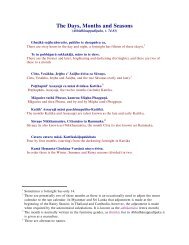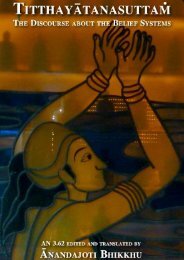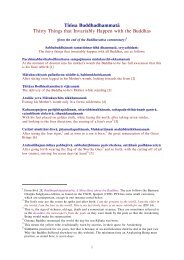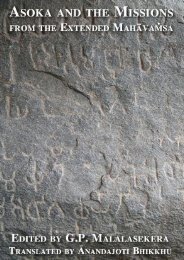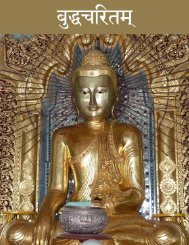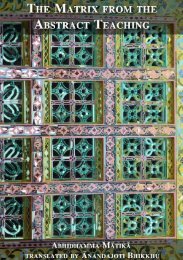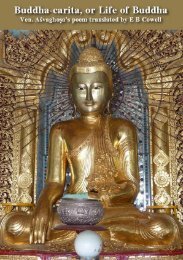The Sanskrit Text of Buddha-carita AÅvaghoá¹£a - buddhanet-de-index
The Sanskrit Text of Buddha-carita AÅvaghoá¹£a - buddhanet-de-index
The Sanskrit Text of Buddha-carita AÅvaghoá¹£a - buddhanet-de-index
- No tags were found...
Create successful ePaper yourself
Turn your PDF publications into a flip-book with our unique Google optimized e-Paper software.
Introduction to the <strong>Text</strong> - 6<strong>The</strong>se three are Addhasamavutta metres, having 2 dissimilar pairs <strong>of</strong> lines(pādayuga) to the verse (105 verses, 10%): Aupacchandasaka (mātrā 16 + 18) Puṣpitāgrā = (16 + 18) Aparavaktra = (14 + 16)and there is also the Śloka metre (accounting for 297 verses, 30%), which by thisstage in its <strong>de</strong>veloment, doesn’t easily fit into any <strong>of</strong> the categories <strong>of</strong> ClassicalIndian prosody. 1<strong>The</strong> main metres are <strong>de</strong>scribed employed in <strong>Buddha</strong><strong>carita</strong> are <strong>de</strong>scribed first, andthen the Classical metres that are used to conclu<strong>de</strong> the various chapters.1. Upajāti (475 verses)<strong>The</strong> Upajāti lines found in <strong>Buddha</strong><strong>carita</strong> are far in excess <strong>of</strong> any other metre, andAśvaghoṣa’s handling <strong>of</strong> the metre is faultless. <strong>The</strong> basic scheme <strong>of</strong> the Upajāti inAśvaghoṣa’s prosody may be <strong>de</strong>scribed as having 2 lines showing the followingstructure:⏓−⏑−¦−⏑⏑¦−⏑−⏓¦¦⏓−⏑−¦−⏑⏑¦−⏑−×This gives two basic lines <strong>of</strong> either −−⏑−¦−⏑⏑¦−⏑−⏓, known as Indravajrā, or⏑−⏑−¦−⏑⏑¦−⏑−⏓, known as Upendravajrā. In the text that is printed here thereare 1285 Indravajrā lines; and 615 Upendravajrā, which therefore shows a markedpreference for the former scheme.<strong>The</strong>se two different lines can occur in any position and any or<strong>de</strong>r in the twopādayuga-s that make up a verse. <strong>The</strong>re are therefore 16 different species <strong>of</strong>Upajāti verse, which have all been given individual names in the Classicalprosodies. 2 It is <strong>of</strong> some interest to see how the lines are distributed here.1 <strong>The</strong> prosodic texts themselves differ one from the other in their classification <strong>of</strong> the metre.It seems best therefore to treat it as being in a class <strong>of</strong> its own.2 I have inclu<strong>de</strong>d these names in the analysis.




